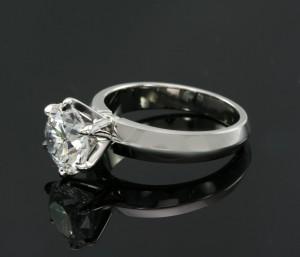 I have been in the diamond business for over 30 years and one of my biggest pet peeves is when a diamond seller, whether it is a jewelry store at the mall or a wholesaler, misrepresents the diamond they are selling. I find this is a practice that happens more and more often and it is giving those of us who are ethical in the diamond industry a bad name.
I have been in the diamond business for over 30 years and one of my biggest pet peeves is when a diamond seller, whether it is a jewelry store at the mall or a wholesaler, misrepresents the diamond they are selling. I find this is a practice that happens more and more often and it is giving those of us who are ethical in the diamond industry a bad name.
Consumers are getting smarter and shopping around for their diamonds, which in turn means that jewelers are fighting for the sales and always trying to “undercut” the other guy by misrepresenting the grading of the diamond they are selling or underselling the diamond to make the sale.
Jimmy, Tommy & Bobby Buy A Diamond
Jimmy, Tommy and Bobby all are looking to buy a diamond. They have found the loves of their lives and are ready to make that big move to getting engaged. Each has decided on the best way to purchase a diamond.
Jimmy goes to the mall to a jewelry store that he has seen advertisements for on national TV. The ads speak to him and he thinks they must have good inventory and know what they are doing if they can afford prime time airtime. He buys a GIA certified 1 Carat round brilliant diamond solitaire in white gold that is H color and is VS2 for $10,000. He thinks he got a great deal.
Tommy heard a local jewelry store advertising on a sports station he listens to in the car, and he decides that is the jeweler for him. He likes that they are local and thinks that their idea of marketing through a sports station is very smart. The jeweler is running a special on a 1 Carat round brilliant diamond solitaire in white gold that is G color VS2 for $6,000. Tommy is impressed and buys the diamond ring.
Tommy’s diamond is not certified and as Tommy is driving home he starts to get nervous and decides to have a certified gemologist look at the diamond. The next day, the gemologist tells him that the diamond is really an H color, but suggests he send it to the GIA laboratory just to make sure. A week later Tommy gets the GIA report that confirms the diamond is really an H color.
Bobby heard about Jonathan’s Fine Jewelers from a friend who had bought his fiancé her diamond there. He makes an appointment with Jon, and listens as he learns all about diamonds and how they are graded. He likes how they want to stay within his budget and don’t push diamonds that he can’t afford. He buys a GIA certified 1 Carat round brilliant diamond solitaire in white gold that is H color and is VS2 for $5,000.
Who got the best deal?
The answer to the first question is easy. Bobby got the best deal.
Which jeweler was dishonest and misrepresented the diamond?
The answer to the second question is more difficult. Tommy’s jeweler was dishonest even though Tommy’s jeweler gave him a better deal. Dishonesty in this case is not related to value.
Misrepresenting the grading of a diamond is dishonest because the consumer is deceived into thinking that he is buying something better than what he is actually buying. Tommy might not have bought the diamond if he had truly known that it was an H.
At Jonathan’s Fine Jewelers, we believe that it is better to lose a sale honestly than to make a sale dishonestly. Fortunately we honestly rarely lose a deal. Would you rather gain a sale dishonestly or lose a sale honestly?
